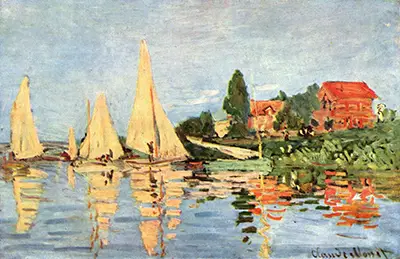He was visiting with his father and his aunt, having left his partner, Camille Doncieux, alone with their son. He painted two paintings at this time: Regatta at Sainte-Adresse and The Beach at Sainte-Adresse.
They are considered to be a pair because their sizes are identical. The perspectives from which the two paintings have been done don’t differ much from each other either. He also did several seascapes at this location.
The painting is a depiction of the regatta, or boat race, at Le Havre. It is a nice and sunny day with a few dispersing clouds. There are well-dressed people on the beach who are watching the regatta.
Several boats with sails are making their way back but because of the perspective, it is hard to distinguish which one is winning. The crowd at the beach are relaxed and watching the spectacle with interest. There is a bright blue fishing boat on the beach too. The colours are bright and sharp and the short strokes of the painting are very representative of the Impressionist style. The sea water is bluish green, and the beach sand is almost white. The picture has a strong feel of relaxation and fun to it.
One of the interesting things about this painting is that the scene depicted in it was visible from Monet's aunt's house. Monet, who spent a lot of time there, made full use of his time. He has also immortalised his father by depicting him in Regatta at Sainte-Adresse. The man in the picture depicted in a grey suit and a straw hat and standing near a sitting man in the black suit is considered to be Monet’s father. The painting is signed by the artist on the sand at the bottom left.
The Regatta at Sainte-Adresse has been shown all over the world since it was first painted, though he didn’t display it for almost a decade after it was completed. The painting was at first rejected by the conventional art critics, so Monet joined with other artists with unconventional tastes to organise independent exhibitions at which Regatta at Sainte-Adresse was often displayed. Today, the painting is on display at The Metropolitan Museum in New York, and is open to the public.
Oscar Claude Monet is a famous French painter who lived and worked in the late half of the 19th century and the first half of the 20th century. He is considered the Father of Impressionism, and is one of the most prolific artists who have painted within this artistic movement. Even the very term of the Impressionism movement comes from his painting, Impression, Soleil Levant. Monet’s speciality was painting sceneries of the French countryside in different seasons and with different lighting.
The son of a ship chandler and grocer and a singer, Monet was aware of his own interest in art from a young age. His mother encouraged him to pursue his passion and Monet was able to go to Le Havre Secondary School of Arts. He also learned from artists such as Jacques-François Orchard and Eugène Boudin.


